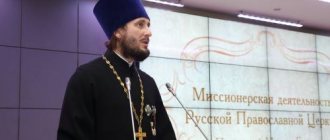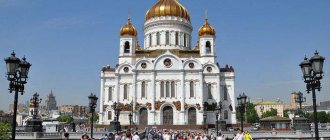Definition and characteristics
A metropolis is a territory, region, district or city, the churches and parishes of which are subordinate to the archbishop appointed by the patriarch and the Holy Synod. Usually it consists of several dioceses, which make up the so-called metropolitan district.
The metropolitanate unites several dioceses and is under the canonical authority of the metropolitan
In the history of the Church, this term was applied to various entities: a city that was the center of an established bishopric, an episcopal see, or a district governed by a bishop, but without bishops subordinate to him. On the territory of the CIS, the first metropolitanate was Kiev, which was subordinate to Constantinople from the moment of the baptism of Rus'.
In the modern Russian Orthodox Church, a district that includes two or more dioceses. The main goal of this territorial entity is the coordination of liturgical, pastoral and any other Christian activities.
In addition, this administrative-territorial unit has a number of special characteristics:
- It is governed by a priest of the highest rank, who has been approved and appointed by the Holy Synod and the Patriarch.
- The boundaries and composition of the district are determined by the Supreme Authority of the Russian Orthodox Church.
- At least twice a year, a meeting of the Bishops' Council takes place in the district.
- The metropolitan is the head of one of the dioceses (rector of the cathedral), which is part of the district subordinate to him.
Thus, a district governed by the highest bishop and including a number of subordinate Orthodox districts is called a metropolis and constitutes the body of the Russian Orthodox Church.
Russian Orthodox Church
The creation of metropolises on the territory of Russia was one of the most important decisions of the Holy Synod, adopted at the last meeting, held on October 5-6, 2011. The activities of the metropolises are regulated by a new document - the Regulations on the metropolises of the Russian Orthodox Church. The main provisions of this document are commented on in the Journal of the Moscow Patriarchate (No. 11, 2011) by the Deputy Administrator of the Moscow Patriarchate and the Secretary of the Inter-Council Presence Commission on Church Administration and Mechanisms for Implementing Conciliarity, Hegumen Savva (Tutunov).
— Father Savva, in the new Regulations the metropolis is named as one of the forms of organizing the interaction of dioceses. What other forms of such interaction exist? What is involved in creating a new form?
— Today in the Russian Orthodox Church the forms of territorial unification of dioceses can be different. If we go from large to small, then these are, first of all, self-governing Churches, exarchates, metropolitan districts and metropolises. In all cases, except for metropolises, their own synod and synodal institutions are formed.
The creation of metropolises as a new level of interaction between dioceses is due to the fact that since May of this year new dioceses have been created, the borders of which do not coincide with the borders of the constituent entities of the Russian Federation. A new situation has arisen: several dioceses are emerging on the territory of one subject of the Federation. For obvious reasons, the question immediately arose about the interaction of these dioceses both among themselves and with the secular authorities. A simple example: how to build relationships with the regional education department on defense industry issues? It is obvious that the department on the Church side needs one coordinator. And there are many such situations.
In this regard, in July the Holy Synod instructed the commission of the Inter-Council Presence, headed by Metropolitan Barsanuphius of Saransk and Mordovia, head of the affairs of the Moscow Patriarchate, to study this issue. As a result of intensive work, a draft document was developed that proposed uniting dioceses within one subject of the Federation into a metropolitan area.
The very concept of “metropolis” appears not for the first time in the history of the Church and has some prototype in the form of those metropolises that existed in the ancient Church. Of course, etymologically, “metropolis” is more likely the center of a region, the main city, rather than a territory, but I believe that the terminology should not cause much concern in this case.
The existence of “intermediate” formations between the highest church authorities, to use modern terminology, and dioceses is well known from history. A four-level structure is known: dioceses, several dioceses are organized into metropolitanates, several metropolitanates are organized into an exarchate, several exarchates are organized into a patriarchate. Although it cannot be said that the four-stage structure existed for a very long time. But the three-stage system, which we now see in Russia, existed historically, was very effective and exists to this day. Although, of course, significant differences in this management system are inevitable both in different historical periods and in different geographical territories.
— The document lists various areas of activity that should be coordinated by dioceses within the metropolises. What is the purpose of such a detailed listing?
— The regulations on metropolises are a church-legal document, and the directions of interaction in it must be spelled out in detail. These are the laws of the genre, if you like.
— We have already touched upon the interaction of new dioceses with government authorities at the regional level. How can interaction between the dioceses themselves be structured? For example, is it possible to say that not every such diocese should create a department of religious education? Such a department can be created in the metropolis and coordinate the activities of several dioceses. Or in each case should the diocesan structure be rigid and repeat the main synodal departments?
— Of course, there should be a proper diocesan structure. This is, first of all, the diocesan council, the diocesan assembly, the diocesan secretary - everything that is provided for by the Charter of the Russian Orthodox Church. And also the chief accountant, because each diocese is a legal entity. As for diocesan departments, the situations may be different. And today there is no uniformity. For example, in the Chukotka diocese, where there are literally a couple of dozen parishes, and in Ekaterinodar, where there are several hundred of them, the diocesan structure, obviously, cannot be the same. This is fine. In one case, there are large diocesan departments with several dozen employees, in the other, parish priests, in addition to serving in the parish, are responsible for one direction or another.
I believe that in the new dioceses united into metropolises, the situation will be different depending on the number of parishes, the nature of the area, and the availability of infrastructure. But one way or another, there must be people under the bishop, albeit not numerous, but responsible for those main areas of church activity that the Council of Bishops determined this year: social service, work with youth, religious education and catechesis, mission. At least there should be separate staffing levels for these four areas. If it is not possible to create a full-fledged diocesan department, then it is quite enough to appoint one responsible person. I repeat: such experience exists in small dioceses, and it has fully justified itself. No one will make demands on the newly formed dioceses that they cannot fulfill.
In addition, the diocesan department of the main city of the metropolis is called upon to help the dioceses. At the same time, there should not be any dictate on the part of the diocesan department of the metropolis. From the point of view of the canons and church law, the newly formed metropolitan dioceses do not differ from the diocese headed by the metropolitan as the ruling bishop. Therefore, this should be the case in practice.
- The regulation is introduced by a new church body - the Bishops' Council. What is his status and what are his tasks?
— Let’s make an important clarification: it is necessary to avoid terminological and ecclesiastical legal confusion between metropolitan districts and metropolises.
The metropolitan districts that operate in Kazakhstan and Central Asia have their own common bodies - synods, which have authority, and synodal institutions, which are executive authorities.
The bishops' councils of metropolises do not have power; they are advisory bodies of bishops in each metropolitan area. They are necessary to resolve the issues we discussed above.
Another example of the general concern of the Bishops' Council is theological schools and seminaries. For example, if there is a school in Saransk, then there is no need to open another school in Krasnoslobodsk or Ardatov. At the same time, since all the dioceses of the Mordovian Metropolis enjoy the benefits of this school, they are called upon to jointly support the seminary. This issue should be resolved in fraternal consultation between bishops within the framework of the Bishops' Council.
—What is the role of the head of the metropolitanate? Judging by the Regulations, he has supervisory functions: to take care, teach fraternal advice, provide care. But at the same time, there is one unexpected function - to conduct pre-trial proceedings. What does it mean?
— Being a senior comrade, a mentor is one of the important functions of the head of the metropolis. Now, when new dioceses are just being formed, it is especially important that in all metropolitan areas its heads are highly experienced bishops who will be able to help the young ones who head the new dioceses.
In addition, the Metropolitan is the coordinator. We know very well that if there is no person personally responsible for coordinating the activities of the dioceses, then nothing will work. The Metropolitan bears this responsibility.
Returning to what was said earlier: it is easier and clearer for the regional leadership and government authorities to conduct a dialogue with someone personally. This does not mean at all that other bishops of the metropolis should be excluded from dialogue with the same governor. This will be contrary to church legal norms. But with mediation or coordination on the part of one person, the metropolitan, this dialogue will be more fruitful.
Perhaps time will show that centralization will also be useful in resolving some issues. However, caution is required here. Each metropolitan diocese is subordinated directly to the highest bodies of church authority. And the metropolitan cannot interfere in relations between the highest authorities and dioceses. Any diocesan bishop, including the diocesan bishop of a new diocese that is part of the metropolis, can directly contact the Patriarch and the chairmen of synodal institutions. In this they differ from vicars, who appeal to the highest authorities through their ruling bishops.
It often happens that complaints against diocesan clergy, and sometimes against bishops, are addressed to the Patriarch. The regulations on metropolises provide that such appeals can also be accepted by the metropolitan. It’s one thing to try to understand the situation from afar, but it’s another thing if the local metropolitan takes part in reconciling the parties on the spot.
Doesn't this usurp the functions of the church court? The Regulations on Metropolises indicate that the courts remain the same: the diocesan court and the General Church Court. The Metropolitan can resolve misunderstandings without formal legal proceedings. This does not mean that church legal proceedings are being abolished, but that in cases where it is not necessary, the metropolitan has the right to resolve the issue independently.
— In other words, this is a pre-trial procedure for considering those cases that do not concern canonical issues and where the parties can agree.
- Yes. From my experience working in the Administrative Office of the Moscow Patriarchate, I can say that a significant number of complaints from priests and bishops are resolved in a pre-trial manner through dialogue and interviews. Cases are transferred to the church court when the possibilities for reconciliation have been exhausted. And the metropolitan, in the case when he cannot achieve a result without formal legal proceedings, should send documents to the General Church Court or to the diocesan court that has jurisdiction over the accused person, that is, at the place of residence or ministry.
— The regulations on metropolises were prepared by one of the commissions of the Inter-Council Presence. Today there is a practice of submitting draft documents for church-wide discussion. The adopted Regulations were transferred to the Synod without such a procedure. What is this connected with?
— As you know, the Inter-Council Presence consists not only of employees of church institutions, but also a wide range of clergy and experts who can examine the assigned topic in a variety of ways. Probably, it could have been done differently - to give instructions to write such a Regulation to the employees of the Administration, the legal service or the historical and legal commission. But the Synod entrusted this to the Inter-Council Presence, a broad collegial body. Thus, in addition to their own work on creating documents that undergo the discussion, publication, and so on you mentioned, individual commissions of the Inter-Council Presence are also involved in this kind of development.
— What was the basis for this document? What church practice did you focus on?
— We studied the materials of the Local Council of 1917-1918, but then the Council did not adopt any specific documents, although there were certain developments in the materials of the relevant department of the Council.
The documents of the Synod under the Patriarchal Locum Tenens, Metropolitan Sergius (Stragorodsky), also turned out to be useful. These materials were published in the “Journal of the Moscow Patriarchate” in 1931-1935 and are available to us in a reissue prepared by the Publishing House of the Moscow Patriarchate several years ago. Perhaps we cannot say that we directly transferred some formulations into the document, but, without a doubt, it was working material for us.
— The adopted Regulations establish the order of interaction between dioceses today. Do you think it is possible to further develop cooperation between dioceses within the metropolis and, accordingly, a new edition of this document in the future?
— The provision has entered into force and will remain in effect. If fundamental questions arise regarding the content, changes can be made at the Council of Bishops. The Synod indicated that with the adoption of the Regulations, it is necessary to make amendments to the Charter of the Russian Orthodox Church and, if any additions are required to the legal status of metropolises, they can be proposed for consideration by the Council of Bishops that will adopt these amendments to the Charter.
“Church Bulletin” / Patriarchy.ru
Difference from diocese
The main differences are the size and number of the population that lives in a certain territory. Both territorial entities are governed by the highest bishops - the metropolitan and the archbishop. They are independent priests with equal rights in the structure of the Russian Orthodox Church and are subordinate to the highest authority in the Church and the Patriarch of All Rus'.
The title of metropolitan in the Russian Orthodox Church is received for special merits
The Metropolitan coordinates the activities of the archbishops, receives regular reports and heads the councils of the subordinate regions. At the same time, he gives a fair assessment of the activities of the bishops and can petition or ask the Holy Synod and the Patriarch for the resignation of the bishops occupying the see.
Important! The Metropolitan is the connecting link between the main Church Council and diocesan structures, but at the same time the Patriarch can directly coordinate and lead them as well.
Subordinate to the archbishop are dean districts, parishes and monasteries, and only dioceses are part of the metropolis. Thus, in the Russian Orthodox Church there is a strict and clear structured connection from smaller parishes to the highest clergy. This system allows the Patriarch to better understand the needs and desires of the population, as well as to lead the entire Church.
Meaning of the word metropolis
In the Western Metropolis, the Patriarch already allowed the local bishops to constantly elect high priests from among themselves and sometimes even appoint them, however, with his blessing; and in the Eastern Metropolis he granted once and for all, without any prior communication with him, not only to elect, but also to appoint metropolitans to the Council of Russian hierarchs from among the Russian clergy, so that this metropolitanate was already independent in fact, and it only had to take the last step to ascend to degree of independent Orthodox patriarch.
In the Western Metropolis, the Patriarch already allowed the local bishops to constantly elect high priests from among themselves and sometimes even appoint them, however, with his blessing; and in the Eastern Metropolis he granted once and for all, without any prior communication with him, not only to elect, but also to appoint metropolitans to the Council of Russian hierarchs from among the Russian clergy, so that this metropolitanate was already independent in fact, and it only had to take the last step to ascend to degree of independent Orthodox patriarch.
Under the rule of the Lithuanian princes and Polish kings, the southern Russian metropolis was in unfavorable conditions for its development; Northern Russian under the rule of the Moscow princes developed more freely and little by little became independent from the Patriarch of Constantinople; the relationship between the central and diocesan church authorities became more natural, but the pressure of secular power on church power increased [I called the second period the period of the northern Russian metropolitanate due to the fact that the center of gravity of Russian church life was then in northern Russia; Southern Rus', although it received its own metropolitan (from the end of the 16th century), but learned a lot from the northern and largely repeated what that one experienced, so my Guide is more concerned with the history of the northern metropolis than the southern one, noting in parallel the phenomena of this latter.] .
Thus, in the chapter “Belokrinitsky Metropolis” the author names a number of cathedrals of the Belokrinitsky Metropolis of the second half of the 30s, of which he was a participant, and its seizure by the Bolsheviks on June 30, 1940.
The Greeks were competitors of these merchants, and therefore the metropolis was in opposition to Svyatopolk II, and the Kiev Pechersk Lavra, a rival of the metropolis, supported Svyatopolk.
In the 30s, a metropolitanate was organized in Kyiv, the first reliable Russian metropolitan appeared (Theopemtus is a Greek by nationality), a metropolitan church was built - the Kiev St. Sophia, and the first all-Russian church council was convened.
Patriarchate of Moscow and All Great Russia and Western Russian Metropolis (1589–1654) Publishing House of the Spaso-Preobrazhensky Valaam Monastery 5-7302-0814-6 Macarius, Metropolitan of Moscow and Kolomna
Metropolitan Kirill from Novgorod moved to live in Kyiv, where he restored the Metropolis of All Rus'” (A.A.
Moldova
Dioceses of the Moldavian Orthodox Church
Dioceses of the Moldavian Orthodox Church:[2]
| Diocese | See | Based | Official site |
| Kishinev | Kishinev | 1813 | [268] |
| Cahul and Comrat | Cahul | 1998 | [269] |
| Ungheni and Nisporeni | Ungheni | 2006 | [270] |
| Balti and Falesti | Balti | 2006 | [271] |
| Tiraspol and Dubossary | Tiraspol | 1998 | [272] |
| Edinet and Briceni | Edinet | 1998 | [273] |
Ukraine
Dioceses of the Ukrainian Orthodox Church (Moscow Patriarchate) as of January 2014
Dioceses of the Ukrainian Orthodox Church (Moscow Patriarchate):[2]
| Diocese | See | Based | Official site |
| Alexandria and Svetlovodsk | Alexandria | 2007 | [211] |
| Balta and Ananyev | Balta | 2012 | [212] |
| Bila Tserkva and Boguslav | White church | 1994 | [213] |
| Berdyansk and Primorye | Berdyansk | 2007 | [214] |
| Boryspil and Brovary | Boryspil | 2013 | [215] |
| Vinnitsa | Vinnitsa | 1933 | [216] |
| Mogilev-Podolsky | Mogilev-Podolsky | 2013 | [217] |
| Vladimir-Volynsky and Kovel | Vladimir-Volynsky | 1996 | [218] |
| Gorlovka and Slavyansk | Gorlovka | 1994 | [219] |
| Dzhankoy and Rozdolnoe | Dzhankoy | 2008 | [220] |
| Kamenskoye and Tsarichanka | Kamenskoye | 2010 | [221] |
| Dnepropetrovsk and Pavlograd | Dnieper | 1775 | [222] |
| Donetsk and Mariupol | Donetsk | 1944 | [223] |
| Feodosia | Feodosia | 2012 | [224] |
| Zhytomyr and Novograd-Volynsky | Zhytomyr | 1940 | [225] |
| Zaporozhye and Melitopol | Zaporozhye | 1992 | [226] |
| Ivano-Frankivsk and Kolomyia | Ivano-Frankivsk | 1957 | [227] |
| Izyum and Kupyansk | Raisin | 2012 | [228] |
| Kamenets-Podolsky and Gorodok | Kamenets-Podolsky | 1795 | [229] |
| Kyiv | Kyiv | 988 | [230] |
| Kirovograd and Novomirgorod | Kropyvnytskyi | 1942 | [231] |
| Konotop and Glukhov | Konotop | 1993 | [232] |
| Kremenchuk and Lubny | Kremenchuk | 2007 | [233] |
| Krivoy Rog and Nikopol | Krivoy Rog | 1996 | [234] |
| Lugansk and Alchevsk | Lugansk | 1991 | [235] |
| Lutsk and Volyn | Lutsk | 11th century | [236] |
| Lviv and Galicia | Lviv | 1539 | [237] |
| Mukachevo and Uzhgorod | Mukachevo | 1945 | [238] |
| Nizhyn and Pryluky | Nizhyn | 2007 | [239] |
| Nikolaev | Nikolaev | 1992 | [240] |
| Voznesensk | Voznesensk | 2012 | [241] |
| New Kakhovka and Genichesk | New Kakhovka | 2007 | [242] |
| Ovruch and Korosten | Ovruch | 1993 | [243] |
| Odessa and Izmail | Odessa | 1837 | [244] |
| Poltava and Mirgorod | Poltava | 1799 | [245] |
| Rivne and Ostrog | Smooth | 1990 | [246] |
| Rovenki | Rovenki | 2013 | [247] |
| Romny | Romny | 2013 | [248] |
| Sarny and Polesskoe | Sarny | 1999 | [249] |
| Severodonetsk and Starobelsk | Severodonetsk | 2007 | [250] |
| Simferopol and Crimea | Simferopol | 1859 | [251] |
| Sumy and Okhtyrka | Sumy | 1943 | [252] |
| Ternopil and Kremenets | Ternopil | 1988 | [253] |
| Tulchin and Bratslav | Tulchin | 1994 | [254] |
| Uman and Zvenigorodka | Uman | 2008 | [255] |
| Kharkov and Bogodukhov | Kharkiv | 1799 | [256] |
| Kherson and Tavriysk | Kherson | 1837 | [257] |
| Khmelnitsky and Starokonstantinov | Khmelnitsky | 1955 | [258] |
| Khust and Vinogradov | Khust | 1994 | [259] |
| Cherkasy and Kaniv | Cherkasy | 1992 | [260] |
| Chernigov and Novgorod-Seversky | Chernigov | 11th century | [261] |
| Chernivtsi and Bukovina | Chernivtsi | 1941 | [262] |
| Shepetivka and Slavuta | Shepetivka | 2007 | [263] |







